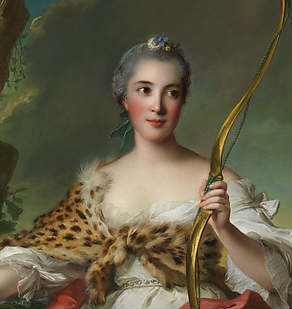Search:: Artists Alphabetically Artists by Country Artists by Century Artists by Movement
Jean-Marc Nattier
1685-1766
French Rococo Portrait Painter
Stylistically Influenced by the following Painters: Peter Paul Rubens and Rembrandt
Education - he studied under his father Marc Nattier and later attended the Académie Royale
Jan Jean-Marc Nattier style is characterized by his gift of capturing a likeness and his insistence on a painterly surface and adoption of a pastel palette favoring royal blues and pinks. Despite Nattier's considerable knowledge of and borrowings from old Dutch masters, he remained in the last analysis French through and through. More than any other artist, Nattier is associated with the creation of the mature Rococo portrait style in France. Among the most productive painters of his generation, he excelled at mythological portraiture of noblewoman and dramatic historical battle scenes. He was highly skilled at marketing his work and presided over a bustling studio in the heart of Paris.
About the Rocco Movement
'The Art of the Aristocracy'
The word is derived from "rocaille" (pebble), but the term referred in particular to the small stones and shells used to adorn the interiors of grottoes. Such shells or shell forms were the primary motifs in Rococo ornament.
he Rococo style began as a backlash against Baroque formality and stuffiness. Unlike Baroque, Rococo is not concerned with religious matters or dramatic expression. The highly decorative art and design movement began in Paris, France in the early 1700s and is sometimes called the style of Louis XV (15th) . The style is profoundly symbolic of the self-indulgence of European aristocratic rulers. Rocco manner is characterized by graceful, enchanting, lighthearted themes and seldom features anything of substance. Sentiment was expressed over reason and emotionalism was expressed over intellect. Paintings are animated and clever, reflecting an impishly sensual daydream.
.
Rococo Portraiture Rocco paintings feature beautiful aristocrats decked out in velvet, elegant laces and rich golden embroideries. The figures are tall and willowy, stylish and charming. The faces are presented as soft and rosy, effeminate and eternally young. Noblemen are depicted wearing feminine coiffeurs, rouged lips and cheeks, often sporting high heels. In a way they resemble modern day drag queens. The Rocco female figures are delicate and light; the faces, are childish and sentimental. The lines of the mouth curve in soft mischief or in a delicate enchanting smile. Characteristic of Rococo art was paintings of carefree aristocrats at play in make-believe settings. These romantic scenes depict luxuriously costumed ladies and gentlemen flirting, picnicking and playing music at gallant country parties. The background scenery is often a serene natural setting with delicate trees and sprays of roses. Colors are a profusion of soothing, light pastels. The Rococo movement was initially restricted to France, later spreading to all of Europe and above all to Germany. The movement continued to develop until the arrival of Neoclassicismwhich attempted to return to the purism of classical antiquity.
Principle Artists of the Rococo Period Pompeo Batoni Italian,1708-1787
Bernardo Bellotto Italian,1720-1780
Francois Boucher French, 1703-1770
Canaletto Italian, 1697-1768
Jean-Baptiste Simeon Chardin French, 1699-1779
Jean-Honoré Fragonard French, 1732-1806
Thomas Gainsborough English, 1727-1823
Francisco de Goya Spanish, 1746-1828
Thomas Hudson English,1701-1779
Jean-Marc Nattier French, 1685-1766
Joshua Reynolds English, 1723-1792
Paul Sandby English, 1730-1809
Jean Antoine Watteau French, 1684-1721
© HistoryofPainters.com If you like this page and wish to share it, you are welcome to link to it, with our thanks. updated 3/7/2017
If you feel you have worthwhile information you would like to contribute we would love to hear from you. We collect proverbs and old sayings from folks all over the globe and appreciate your participation. When submitting please, if possible, site the source and provide English translation. Email to historyofpainter@gmail.com
